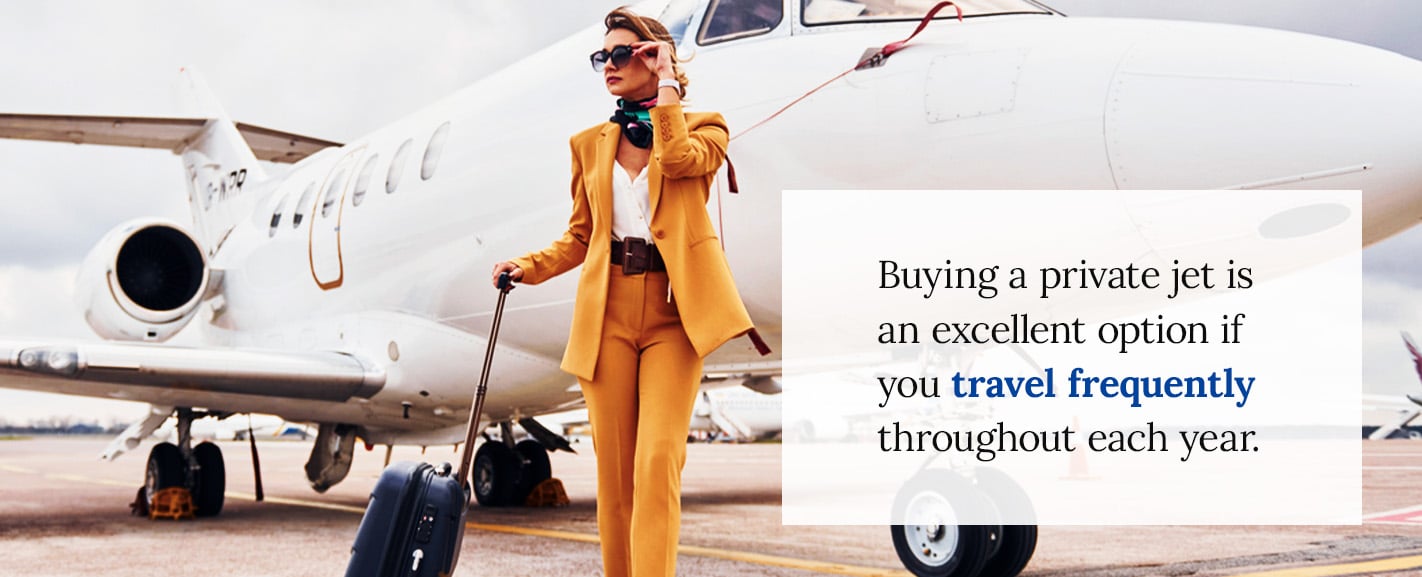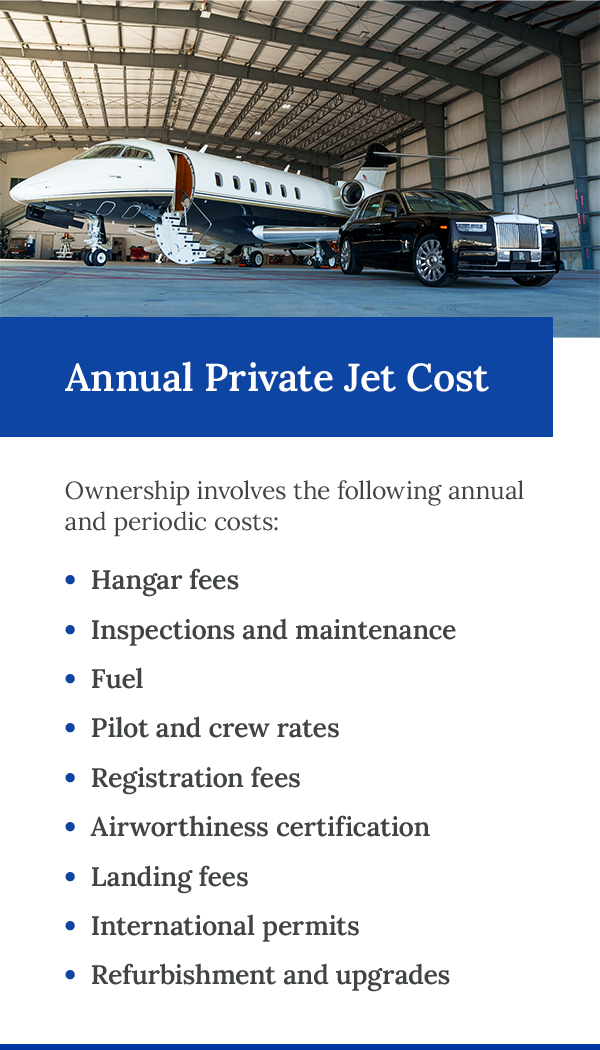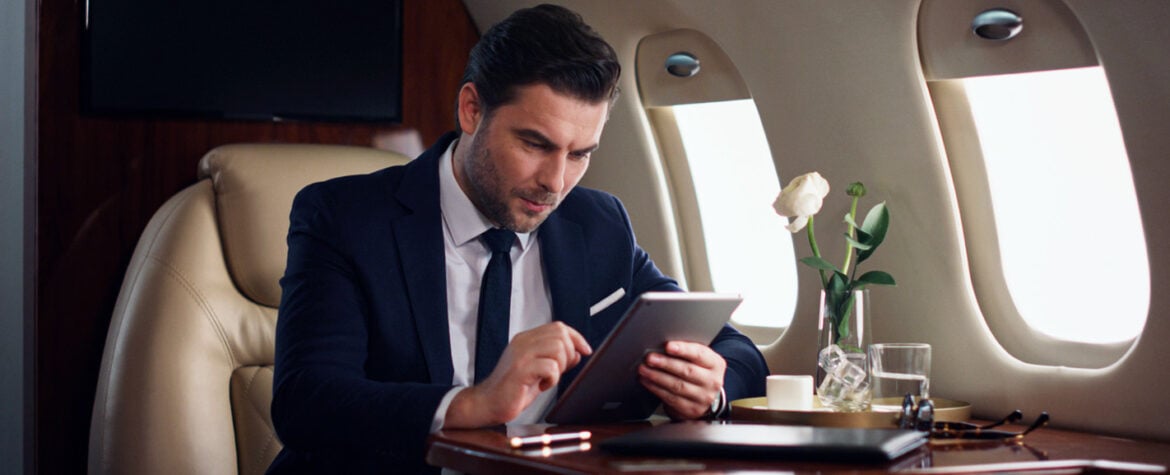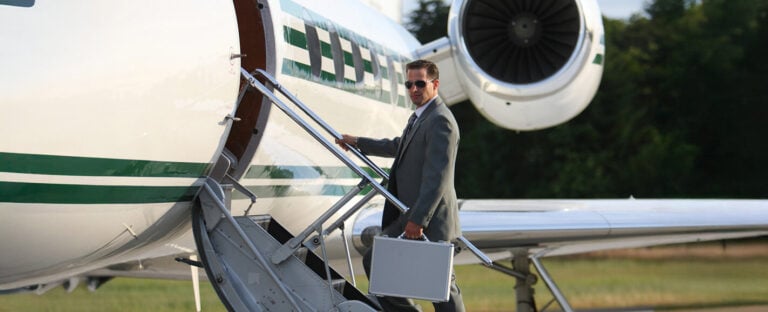Understanding which type of private jet you should buy is the first step to investing in an aircraft. It’s important to consider key factors such as comfort preferences, typical travel routes, aircraft range, fuel efficiency, and the highest number of passengers you plan to fly with. When you understand these details, you can choose an aircraft that meets your precise needs.
It’s also essential to work with an experienced broker when finding and purchasing a private aircraft. A buyer’s broker can help you navigate the complex market, find the type of aircraft you desire, verify its value, and negotiate contract details.
Benefits of Buying a Private Jet
Owning a private aircraft offers the following advantages:
Privacy
You and your traveling party can enjoy privacy and confidentiality when you own an aircraft. This grants you the ability to hold important discussions or conduct meetings securely. You also have the freedom to do as you please during your flight.
Comfort
A private aircraft offers enhanced comfort. Many models feature reclining seats and lie-flat options for ultimate in-flight relaxation. You can also choose or customize various models with your preferred amenities such as the following:
- Refreshment centers
- Full-service galleys
- Lavatories
- Electronics for in-flight entertainment and work
- Productivity options
- Offices and conference rooms
- Cabin crew
Convenience
Private jets add convenience to your travels. Rather than waiting for a commercial flight to become available or scheduling a private charter, you can choose to travel when it suits you and your party best.
Safety
Flying via private aircraft is highly secure, making it ideal for high-profile business professionals or public figures. It also enhances safety for individuals with health concerns who want to avoid germs or allergens. In a private jet, you have full control over your surroundings.
Opportunity to Reduce Cost
You can rent your aircraft to interested parties looking for charter flights and help offset the costs of ownership.

When Should You Consider Buying a Private Jet?
Buying a private jet is an excellent option if you travel frequently throughout each year. Consider how many hours you flew in the past year and how many trips you have planned in the upcoming years. If your plans involve consistent flights throughout the year, investing in a private aircraft is practical.
What Should You Consider When Buying a Private Jet?
Choosing the right private jet depends on various factors such as the following:
Range and Typical Routes
A private jet’s range indicates how many miles it can fly before needing to refuel. Before choosing an aircraft, consider how many miles you typically travel and how often you are comfortable stopping for fuel. If you generally travel shorter distances, a lighter jet is sufficient. However, a long-range jet is ideal for transcontinental or international trips.
Number of Passengers
How many passengers do you typically fly with? Take your family, friends, and business partners into account. Depending on the types of trips you take, you may want to accommodate a large group.
Preferred Amenities
What type of in-flight comforts and conveniences do you need? You might plan to work in the air, or you may prefer to pass the time with entertainment such as music and movies. If relaxation is a priority, consider a jet with reclining sleeper seats. Food is another important factor because you can choose between a compact refreshment center and a fully equipped galley.
Aircraft Sizes
An aircraft’s size determines its range and how many passengers it can carry. Consider which of the following sizes best meets your needs:
Very Light
Very light jets (VLJs) are ideal for short runways and trips. They range about 1,000 miles and can seat four to six passengers. A VLJ features fewer amenities than larger jets but typically includes a private lavatory.
Light
Light jets, also known as small jets, are another excellent option for short trips. They range approximately 1,500 to 1,900 miles and can seat seven to eight passengers. A light jet’s amenities often include a private lavatory, reclining seats, a small refreshment center, and limited electronics.
Midsize
A midsize jet is ideal for longer or transcontinental trips. These jets range about 2,000 to 3,000 miles, and they can seat five to 10 passengers. You can enjoy amenities such as a spacious cabin, a refreshment center, a private lavatory, and in-flight work or productivity options.
Super-Midsize
Super-midsize jets are perfect for longer, intercontinental trips. They can seat eight to 10 passengers and range approximately 3,200 to 3,600 miles. A super-midsize jet features more luxurious amenities such as a larger refreshment center, in-flight baggage access, and enhanced in-flight entertainment or productivity options. Some super-midsize models also feature lie-flat sleeping options for ultimate comfort.
Heavy or Ultra-Long Range
Heavy or ultra-long-range jets are ideal for extended-range intercontinental trips. A heavy jet can typically seat nine to 16 passengers and ranges between 4,000 and 7,500 miles. It is also a highly configurable aircraft that you can customize to fit your preferences. Depending on your in-flight needs, you can include conference rooms, an enclosed bedroom, a private lounge, offices, full-service galleys, and a cabin crew. You can also add comfortable lie-flat sleeping options for multiple passengers inside a heavy jet.

Which Private Jet Is Best to Buy?
Various aircraft makes and models offer optimal range, amenities, style, and fuel economy. Consider the following popular jet options in your search:
Cessna Citation
The Cessna Citation comes in various models of the following sizes:
- Light: The Cessna Citation CJ3 is a light aircraft that offers exceptional short-field performance and can cruise at a speed of up to 400 knots. The CJ3+ is an enhanced version featuring advanced navigation, greater fuel efficiency, and additional safety features. The CJ4 model features large windows, enhanced power, and more space.
- Midsize: The Cessna Citation XLS and XLS+ models provide optimal comfort and performance, and they can operate from shorter runways. The XLS+ boasts enhanced cabin management systems and soundproofing, and its seating arrangements are flexible.
- Super-midsize: Cessna Citation’s Sovereign and Sovereign+ are super-midsize models with a range of up to 2,800 nautical miles. The Sovereign+ features enhanced avionics and cabin connectivity options.
Embraer Phenom 300
The Embraer Phenom 300 is a light business jet with a spacious cabin, comfortable seating, and large windows. It is popular for its performance, advanced avionics, and safety features such as runway overrun awareness.
Bombardier
Bombardier manufactures jets in the following sizes:
- Midsize: The Bombardier Learjet 60 is popular for its sleek design, efficient operation, and spacious cabin. Its fast cruise speed results in shorter travel times, and it has a range of approximately 2,400–2,783 nautical miles.
- Super-midsize: The Bombardier Challenger 300 and Challenger 350 are super-midsize models with ranges slightly above 3,000 miles. The Challenger 350 offers enhanced fuel efficiency, refined interior features, and advanced avionics.
- Ultra-long range: Bombardier’s Challenger 605 is a large luxury aircraft that can seat up to 12 passengers. It has a range of up to 4,000 miles and cabin features such as a galley, sleeping accommodations, and in-flight connectivity.
Private Jet Cost
Before choosing and investing in a private jet, it’s important to understand the costs. Factor the following expenses into your budget before making a decision:
Upfront Cost
A private aircraft’s upfront cost varies by the model you choose and how well your broker negotiates the price. You must also factor in additional costs, such as prepurchase inspection fees and taxes, to determine your total upfront investment.

Annual Private Jet Cost
It’s also important to understand the annual cost of owning a private jet. Ownership involves the following annual and periodic costs:
- Hangar fees: Purchasing or renting hangar space protects your aircraft from theft and weather damage.
- Inspections and maintenance: A jet requires regular inspections and maintenance to operate efficiently and maintain longevity.
- Fuel: Fuel is one of the main costs of aircraft ownership and use. Pay attention to a jet’s fuel efficiency before purchasing it to help reduce fuel costs.
- Pilot and crew rates: Pilot and crew rates depend on your flight hours and whether you hire your own crew or pay into a pilot pool. Hiring your own crew requires you to pay each individual an annual salary. If you pay into a pilot pool, you have access to a group of pilots certified for your specific type of aircraft.
- Registration fees: The Federal Aviation Administration (FAA) requires private jet owners to pay a registration fee for their aircraft upon purchase and renew it every seven years.
- Airworthiness certification: An annual airworthiness certificate officially states that your aircraft is airworthy and meets safety standards.
- Landing fees: You must pay landing fees each time you use an airport’s facilities and runways.
- International permits: Some countries require you to pay a fee to fly through their airspace. If you plan to travel internationally, research which countries you plan to fly through and what they charge. These fees typically present as taxes on landing fee invoices.
- Refurbishment and upgrades: You may wish to refurbish or upgrade your aircraft’s features in the future. Consider what upgrades you might want to perform and how much they typically cost.
Where to Buy a Private Jet
You can buy a private jet from various locations across the country. Before investing in an aircraft, it’s important to find a reputable company that offers expertise and a personal approach to the entire process. Working with a trustworthy company can help you maximize your investment.
How to Buy a Private Jet
Buying a private jet is a smooth, exciting process when you have the proper support. There are typically thousands of jets on the market, so it’s important to know what you’re looking for and how to find the best value.
Importance of Working With a Broker
Working with a buyer’s broker is vital for a smooth aircraft purchase. A broker is an expert who can help you protect your investment, assisting you with details such as:
- Helping you navigate current market conditions.
- Searching the market for aircraft models that meet your needs and budget.
- Creating a short list of potential purchases.
- Finding potential savings.
- Performing aircraft maintenance history research to determine an aircraft’s value.
- Completing prepurchase inspections to ensure the aircraft is in the expected condition before purchase.
- Making an offer and negotiating for the best price and purchasing conditions.
- Preparing your contract with the right legal resources.
- Completing forms such as the bill of sale and registration correctly.
- Minimizing tax liability.
Understanding the Process
When you approach a private aircraft broker to make a purchase, you may have a general idea of the type of aircraft you need or a precise model in mind. Your broker will ask specific questions concerning your budget, preferred amenities, expected flight hours, and maximum passengers to understand your exact requirements.
Next, the broker begins market research to find aircraft models that meet your criteria. You will receive a report with the following options and details to help you make an informed decision:
- Price
- Amenities
- Aircraft identifiers
- Days on market
- Aircraft value reference (VREF) evaluations
- Entire market overview
Full vs. Fractional Ownership
Full aircraft ownership means you have sole ownership over the aircraft and are responsible for associated costs. Fractional ownership enables you to purchase a share of an aircraft, divide its associated costs between multiple owners, and use it for a specific number of hours annually. Full ownership offers more freedom and convenience because you can use it whenever you need to.
Generating Charter Revenue With Private Jet Management Services
Private jet management services help you offset aircraft ownership costs with charter revenue. Latitude 33 Aviation offers private jet management services to help you manage your aircraft and book charter flights to help you make revenue off of your investment. With this service, you can also take advantage of the following discounts:
- Fuel
- Fleet insurance
- Parts and labor
Find a Private Aircraft With the Help of Latitude 33 Aviation
Finding and purchasing an aircraft is an exciting endeavor that requires skill and expertise. Understanding your needs and preferences is the first step to owning a private jet. Once you know what you’re looking for, you can begin your search with the help of Latitude 33 Aviation. You can trust us to approach aircraft transactions from an operator’s point of view, focusing on an aircraft’s true value beyond its price.
Our experts have the resources and knowledge to help you navigate the complex aircraft market and focus on the details that matter most. We provide in-depth insights and valuations to achieve excellent financial results and ensure you find the best options available. Contact our aircraft experts to begin your search.






Comments are closed.